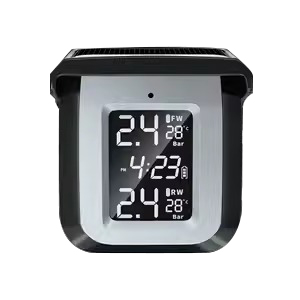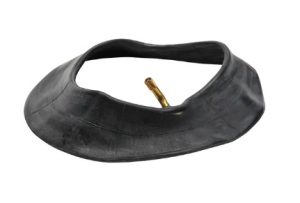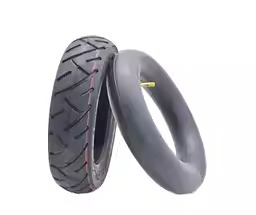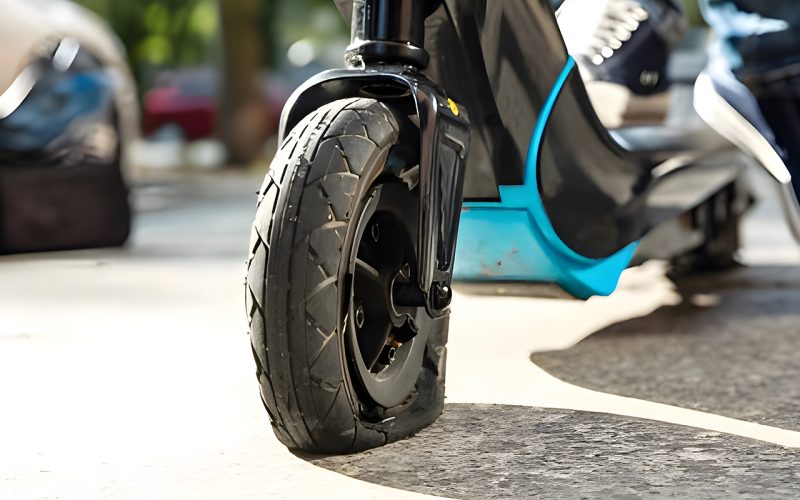Signs of Air Leakage
|
Causes of Air Leakage
|
Symptoms
|
Solutions
|
Images
|
|---|---|---|---|
|
Tire Pressure
|
The specified PSI (pounds per square inch) value is listed on the tire sidewall. The tire pressure is approximately 4 PSI below the recommended value.
|
Inflation is recommended, always maintaining the specified air pressure in the scooter tires.
|
 |
|
Inner Tube
|
Continuously flattens
|
Check the inside of the tire or rim for any sharp edges or objects that could poke holes in the tube and cause air leakage.
|
 |
|
New Inner Tube
|
Flat
|
Always ensure that the pressure in the tube is maintained at around 1 PSI. This will keep it in shape and prevent any squeezing or folding. In addition, tighten the main hub bolts in a star shape to ensure uniform bolt torque.
|
Tire Repair
|
Tubeless Tires
|
Tubed Tires
|
|
|---|---|---|
|
Images
|
 |
 |
|
Leakage
|
Small Puncture: Seal the puncture using tire sealant.
Large Puncture: Install a new tire.
|
Patch or replace the inner tube.
|
|
Installation
|
Use an air compressor capable of providing at least 120 PSI to reinstall the tire onto the rim.
|
Do it yourself or take it to a mechanic/bike shop with experience in tire replacement.
|
|
Tire Pressure
|
Ensure the pressure does not exceed 60 PSI before riding.
|
|
|
Reinflation Frequency
|
Reinflate at least once a week if ridden frequently.
|
Reinflate at least once a week if ridden frequently.
|
|
Reason for Reinflation
|
Riding with low PSI can lead to easier punctures or leaks around the sidewalls.
|
Riding with low PSI can lead to easier punctures or leaks around the sidewalls.
|
|
Recommended Products
|
Tire Slime, Valve Stem Extenders
|
Air leakage can be caused by a number of different factors. Please ensure that the following conditions are always met:
|
Tire Pressure
|
Always maintain the air pressure in the scooter tires. The specified PSI value is listed on the tire sidewall. Once the pressure drops about 4 PSI below this value, it is recommended to inflate. (Therefore, once a 50 PSI tire becomes about 46 PSI, inflate it.)
|
|
Installation
|
When installing a new tube, always ensure the tube pressure is maintained at about 1 PSI. This will keep its shape and prevent any squashing or folding (which can cause a flat). Also, tighten the main hub bolts in a star pattern to ensure even torque.
|
|
Preventing Leaks
|
If your inner tube continuously flattens, check the tire and rim for any sharp edges or objects. These might puncture the tube and cause air leakage.
|
How to Prevent Electric Scooter Flat Tires?
You can take some simple steps to prevent flat tires on your electric scooter, including:
- Regularly check tire pressure.
- Avoid sharp objects and potholes while riding.
- Use high-quality, puncture-resistant tires.
What to Do If Your Tire Flattens While Riding?
If the scooter tire suddenly goes flat and the handlebar veers suddenly in one direction, remain calm and do not panic. At this point, the rider should firmly grip the handlebar and maintain a straight course. Regardless of whether the front or rear tire goes flat, release the throttle, gently brake the rear wheel, or use inertia to slow the scooter, and finally come to a gradual stop.
How to Maintain Tires?
|
Clean debris from the tire tread after riding.
|
After riding, there may be debris stuck to the tire surface. If you find small stones, glass, or other objects in the tire tread, remove them promptly to avoid damaging the rubber layer.
|
|
Clean oil stains from the tires as soon as possible.
|
Since tires are made of rubber, try to avoid contact with hydrocarbon-based lubricants (motor oil, kerosene, gasoline) during daily riding and parking, as these can accelerate tire aging. Additionally, avoid contact with alcohol, refrigerants, or electrolytes. If the tire accidentally comes into contact with these liquids, it is recommended to wash it with soapy water, as soapy water is slightly alkaline and can neutralize these stains.
|
|
Regularly Check the Tire Valve Stem
|
Check the tire valve stem and ensure it is covered to prevent air leakage and maintain the tire pressure within the recommended range. If you discover valve leakage, replace or patch it immediately!
|
|
Maintenance and Replacement
|
Generally, the tire life span is between 2,000 to 3,000 miles. If you exceed this mileage, even if the tire still appears usable, it should be replaced. Especially if you notice any of the following three issues:
|
Three Things to Consider for Long-Term Storage
If you will not be using the electric scooter for a long period, please note the following three points to store it properly:
|
Environment
|
Ensure the scooter and tires are stored in a dry environment, avoiding dampness and direct sunlight to prevent accelerated tire aging.
|
|
Inflation
|
Check the tire inflation periodically. If the tire is left un-inflated for a long time, it can crack and deform, significantly reducing the tire’s lifespan.
|
|
Packaging
|
If the electric scooter is not going to be used for a long time, wrap the tires in plastic bags if possible.
|
FAQ
How much air to put in electric scooter tires?
The optimal tire pressure for electric scooters is usually in the 40 to 50 PSI range. Manufacturers often provide recommended tire pressures, so be sure to check the owner’s manual or the tires themselves for exact numbers.
However, the optimal pressure depends on the weight of the rider. Riders weighing less than 70 kilograms should reduce tire pressure by 3-5 PSI, while riders weighing more than 100 kilograms should increase tire pressure by 3-5 PSI.
Weather also affects tire pressure. Tire pressure increases with friction during use, so tire pressure in cold weather will continue to increase as the weather gets warmer. Make sure that tire pressure is always at the optimum tire pressure, otherwise too low or too high a tire pressure may result in a blowout.
More Reading













